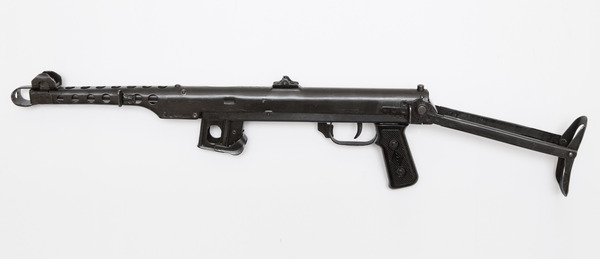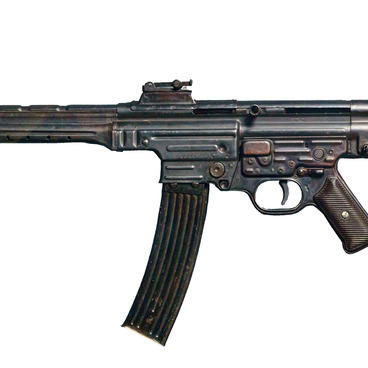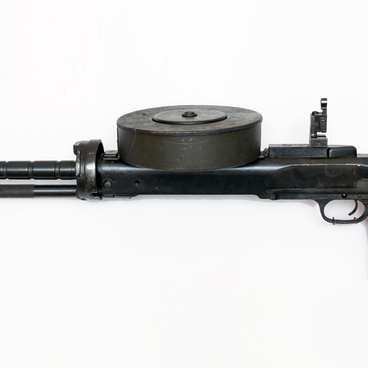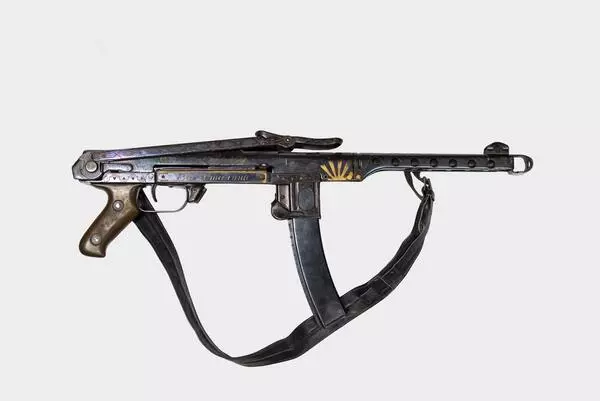The exhibition titled “The Feat of the Army” includes a unique firearm — Sudayev’s submachine gun known as the PPS. It is considered the best submachine gun of World War II.
When this firearm was developed, the Red Army was using the famous PPSh-41 designed by Georgy Shpagin. It proved itself a reliable weapon that was easy to produce. However, the large size and weight made it difficult to use in narrow trenches and cramped spaces in street fighting, and inconvenient for reconnaissance scouts, paratroopers, and armored vehicle crews. Moreover, the war economy required reducing the production costs of submachine guns. As a result, a competition was announced in 1942 to design a light, compact, and cheap alternative that would be as efficient in action as Shpagin’s submachine gun.
The new model was developed by the weapons designer Alexey Sudayev in besieged Leningrad. The Road of Life was used not only to supply food to the city and evacuate civilians but also to export new weapons.
The PPS has a typical design for a submachine gun of that period. It is an automatic blowback-operated weapon, firing from the back sear. The gun has no switch for selecting a firing mode. The weapon is fed from curved 35-round box magazines. Most components of the PPS were produced by stamping which simplified the production and reduced the costs.
After troop trials, the submachine gun was adopted into service under the name of the PPS-42. The gun was produced for the Leningrad Front at the Sestroretsk Arsenal. Next year, a modified version known as the PPS-43 was released. Despite the numerous advantages over Shpagin’s submachine gun, the PPS never replaced it completely. However, a decision was made to keep up the volume of production of submachine guns. During the war, a copy of the PPS for the 9×19mm cartridge known as the M/44 was produced in Finland. Before the Siege of Leningrad was completely lifted in January 1944, a total of 46,572 submachine guns of both these modifications had been manufactured.
After World War II, Sudayev’s submachine guns were often used in local conflicts, including the Korean War and the Vietnam War.
When this firearm was developed, the Red Army was using the famous PPSh-41 designed by Georgy Shpagin. It proved itself a reliable weapon that was easy to produce. However, the large size and weight made it difficult to use in narrow trenches and cramped spaces in street fighting, and inconvenient for reconnaissance scouts, paratroopers, and armored vehicle crews. Moreover, the war economy required reducing the production costs of submachine guns. As a result, a competition was announced in 1942 to design a light, compact, and cheap alternative that would be as efficient in action as Shpagin’s submachine gun.
The new model was developed by the weapons designer Alexey Sudayev in besieged Leningrad. The Road of Life was used not only to supply food to the city and evacuate civilians but also to export new weapons.
The PPS has a typical design for a submachine gun of that period. It is an automatic blowback-operated weapon, firing from the back sear. The gun has no switch for selecting a firing mode. The weapon is fed from curved 35-round box magazines. Most components of the PPS were produced by stamping which simplified the production and reduced the costs.
After troop trials, the submachine gun was adopted into service under the name of the PPS-42. The gun was produced for the Leningrad Front at the Sestroretsk Arsenal. Next year, a modified version known as the PPS-43 was released. Despite the numerous advantages over Shpagin’s submachine gun, the PPS never replaced it completely. However, a decision was made to keep up the volume of production of submachine guns. During the war, a copy of the PPS for the 9×19mm cartridge known as the M/44 was produced in Finland. Before the Siege of Leningrad was completely lifted in January 1944, a total of 46,572 submachine guns of both these modifications had been manufactured.
After World War II, Sudayev’s submachine guns were often used in local conflicts, including the Korean War and the Vietnam War.







